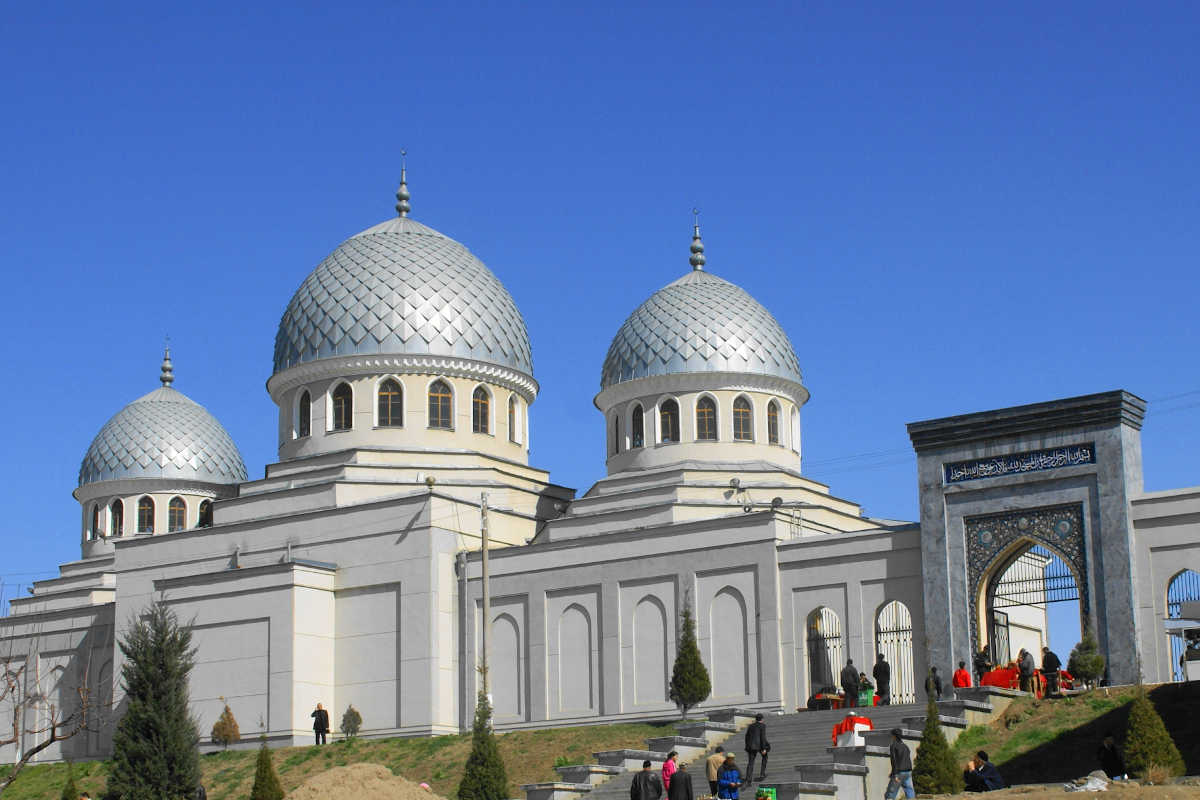Tashkent - Khoja Akhrar Vali Mosque
The Khoja Akhrar Vali Djuma Mosque (Friday Mosque) is the foundation of the Registan Ensemble, located in the area of the Chorsu Bazaar Square in Tashkent. It is the only example of a Friday court-type mosque practised in Central Asia in the late Middle Ages.

The main building is a cuboid structure, roofed by a dome with four windows in a low drum. The east wall facing the courtyard is intersected by a large arch. The dome of the structure is sphero-conical, without ornamentation. The dome is based on sphero-conical sails. The arch of the arch niche at the entrance portal is lancet-shaped, not Central Asian, but rather Gothic abraded. The mosque has an elongated rectangular plan with a large building volume at the end of the east-west longitudinal axis.
The foundations of the mosque were laid in the IX century, after the Arab conquest of ancient Zoroastrian Tashkent, then called Chach.
In 819, the young Emir Yahya ibn Asad, who had just received a letter from the Arab Viceroy in the eastern part of the Caliphate to rule all the lands of what is now the province of Tashkent, stopped his horse at the hills that are still clearly visible between the three city squares – Chorsu, Chodra and Eski-Juwa. “Here we will build our capital,” Yahya said to his entourage, which moved respectfully behind him, “on this hill shall stand Madinah ash-Shash, the northern outpost of Mawara’unnahr!” In his wake were Turkish guards who unanimously repeated the commander’s words, “Yes, yes, here the city of Shash will rise!” In the language of the Turks, “Madina ash-Shash” sounds like “Shashkent”. And on the highest point of the chosen hill, Yahya ibn Asad ordered the foundation stone to be laid for the first Friday Mosque in Tashkent.
In 1432, Ubaydullah Khoja Akhrar, one of the most famous figures in the social life of the Temurid dynasty, who was born in 1404 in the mountain village of Boghistan near Tashkent, visited Tashkent. On his departure, Khoja Akhrar Vali ordered the construction of a large Friday mosque and madrasa in the old Gulbazar Mahalla of Tashkent. Legend has it that Ubaydullah gained the money for the construction by selling scraps of thread that formed by themselves on the edges of rolls of cloth cut into standard pieces. Whether it is true or not, however, on the old foundations left over from the first mosque in Tashkent at the time of Yahya ibn Asad, a characteristic ashlar with a dome and a vaulted ceiling open to the east rose in the mid-15th century.
Opposite the old main entrance of the mosque, which used to be on the north side, a modest one-storey medrese was built in 1451. Today it no longer exists, as the city administration decided in 1954 to dismantle it for bricks needed for the restoration of neighbouring buildings.
Tashkent, as the city is called, is located close to the mountains, in the earthquake zone. Therefore, many of the medieval monumental buildings here often suffered from the earthquakes, sometimes even collapsing altogether. The Friday Mosque was not spared frequent restorations. In the 19th century, during the heyday of the independent state of Tashkent under the administration of the hokim (mayor) of Sheikhantahur Yunus Khoja, the main dome was thoroughly repaired and the vaulted galleries with cells around a long inner courtyard were completely rebuilt.
Severe damage to the main mosque was caused by a strong earthquake in 1868, which visibly damaged most monuments of medieval architecture in Tashkent. The mosque was out of use for almost two decades. It was only in 1888 that it was finally restored at the expense of the Russian Tsar Alexander III, which is why it became known as the “Tsar’s Mosque”. And although the appearance of the building had to be slightly altered during the reconstruction, it still made a very impressive impression. Suffice it to say that it is the third largest Friday mosque in Uzbekistan. Only two buildings of this kind – Bibi-Khanum in Samarkand and Kalon Mosque in Bukhara – are better.
In the past, when there were no tall buildings, the dome of the Khoja Akhrar Vali Juma Mosque could be seen from all sides, especially from the Chorsu Bazaar, the oldest in Tashkent, which has been bustling in the same spot for over a thousand years. The architectural ensemble around the Khoja Akhrar Vali Juma Mosque is now almost completely destroyed, except for a heavily restored building of the Kukaldash Medrese and the dome of the Gulbazar Mahalla Mosque. Nowadays, the original appearance of this remarkable corner of historic Tashkent can only be imagined through rare old photographs.
At the time when photography was still in its infancy, photographers liked to climb the 15-metre-high dome of the main building of the Khoja Akhrar Vali Mosque to take bird’s-eye views of the panorama of old Tashkent with their then imperfect equipment.
The mosque was reconstructed in 2003, using modern methods of construction and decoration. Now not one, but three large domes crown the historic Old Town hill, the mosque looks chic and festive and many people come here. And the convenient location – nearby is one of the oldest bazaars in Tashkent.
